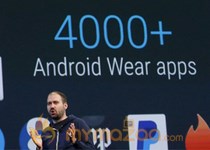Demand for the Apple Watch is steady and growing, according to tech market researcher IDC. The analyst firm’s input follows recent data from Slice Intelligence that showed a sharp dip in June sales for the Watch.
Slice Intelligence’s data, released last week, is not an accurate depiction of overall global supply and demand, according to IDC. Slice measured online Apple Watch sales in the U.S.
“We’ve been talking to the supply chain and talking to other analysts, from everything we hear sales are going up, not down,” Jitesh Ubrani, a wearables analyst at IDC, told FoxNews.com, referring to the group of suppliers that build components for the Watch.
Though Ubrani said IDC tracks shipments into the sales channel, not sales per se, “whatever we’re seeing [there] suggests that the numbers are increasing not decreasing,” he said. IDC does not plan to publish its official numbers for wearables until the end of August, Ubrani added.
Related: Is the Apple Watch a bust? Depends who you ask
In the U.S., the Apple Watch was available only by ordering online from Apple from April 10 until roughly mid-June, when the Watch also became available in physical Apple stores.
Slice concedes that its data do not reflect this. “What’s the reason behind the decline [from mid-June] in online sales? We don’t know but it’s quite possible that’s because sales are beginning to shift into the store,” Slice Chief Data Officer Kanishka Agarwal told FoxNews.com.
Slice's data - which it provided to FoxNews.com - shows sales dropping off steeply and steadily after mid-June: from typically north of 20,000 units daily at the beginning of the month to below 10,000 units in the last half of June and sometimes even below 5,000 units.
“Knowing Slice's methodology and the fact that sales really started to slide at the approximate moment Apple added in-store purchases, it is really hard to come to any other conclusion,” Stephen Baker, vice president, industry analysis at the NPD Group, told FoxNews.com in an email. “The acceleration in the decline is likely the result of a lot of potential Watch buyers moving into the store from being forced to complete the transaction on online,” he said.
Slice’s Agarwal agrees. “It’s a sign that the mass market, which is now buying these devices, is a little more cautious. [Those consumers] want to touch, feel, and play with the Watch,” Agarwal said. Both IDC and Slice made the point that the sales surge after online preorders began on April 10 likely represented early-adopters – not necessarily the mass market.
Related: Apple Watch review: A new convert
An analyst at market researcher Gartner agrees that there are merits to purchasing in-store as opposed to online. “Purchasing the Watch in a physical Apple store would be preferable to many people versus buying it online,” said Angela McIntyre, a research director at Gartner, in a response to an email query. “The purchase experience for luxury goods is different than for consumer electronics, and Apple Watch can be considered a luxury item,” she said.
Slice’s Agarwal also wanted to make sure he is clear about the kind of sales his company tracks – a possible factor in some of the confusion last week. “To clarify the methodology, we are measuring online sales in the U.S. of the Apple Watch,” he said. Those sales are measured by email receipts from a group of panelists that represent online shoppers, who have agreed to participate in Slice’s research.
The root cause of the squabbles about sales data is Apple itself. The company has been stoking speculation because it isn’t providing any sales updates for the Watch, which it typically does for a successful product launch like the iPad or iPhone.
Last year, Apple said that it would not be publishing unit sales of the Watch in its quarterly earnings reports.
Analyst sales estimates for the Watch range from 3 million to 5.7 million in Apple’s third quarter, which ended June 27.
Morgan Stanley's Katy Huberty said in a June 24 research note discussing the Apple Watch that the "interest level (proxy for demand) in the product five and six weeks after launch is about 20% higher than the first-generation iPhone in mid-2007."
Huberty added that "Watch interest in the week of launch was about half that for the first iPhone, but the Watch has seen a much smaller deceleration since the initial spike. Both products had limited distribution at the beginning - iPhone at AT&T and Watch on the Apple online store - but the Watch has seen more supply constraints due to some component issues and we believe likely conservative demand forecasts by Apple."












